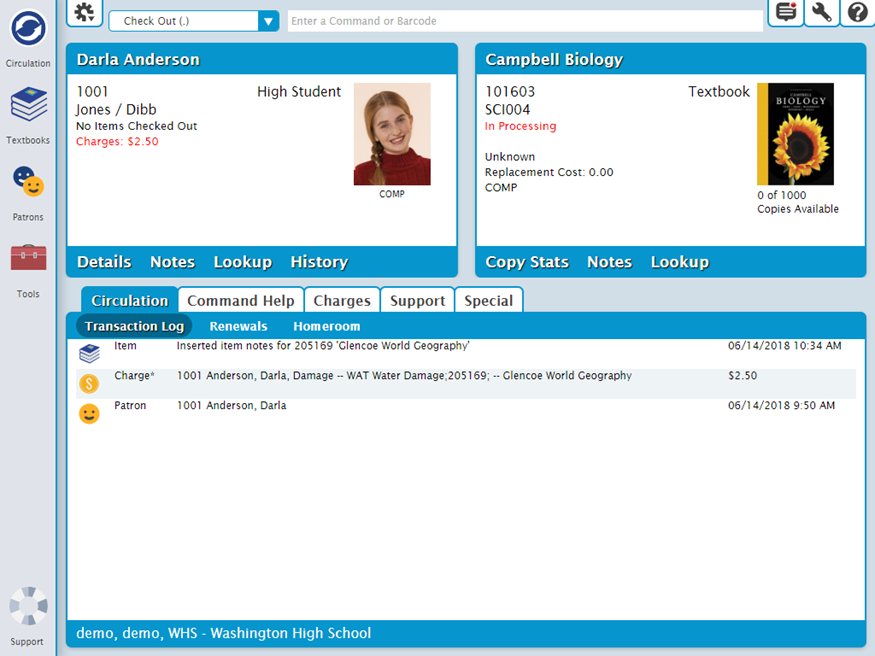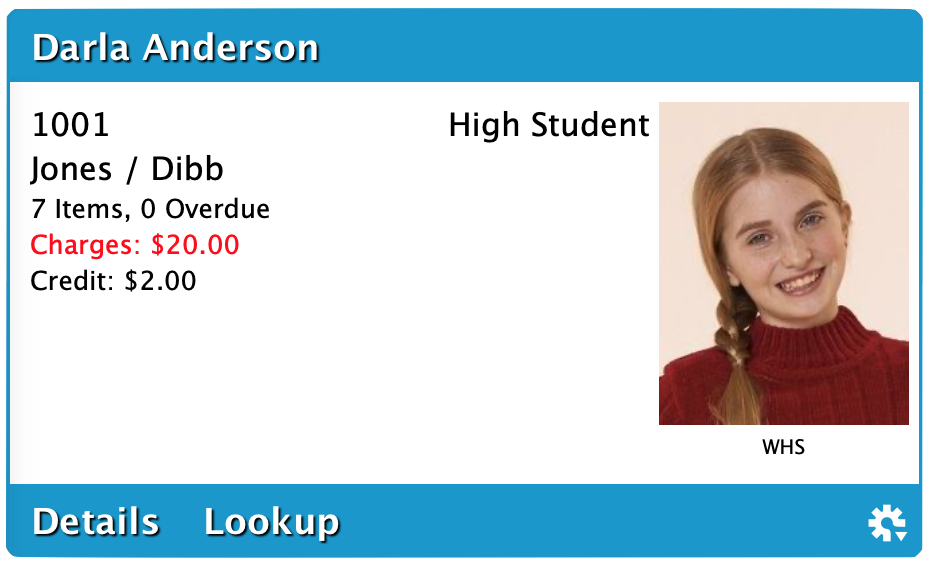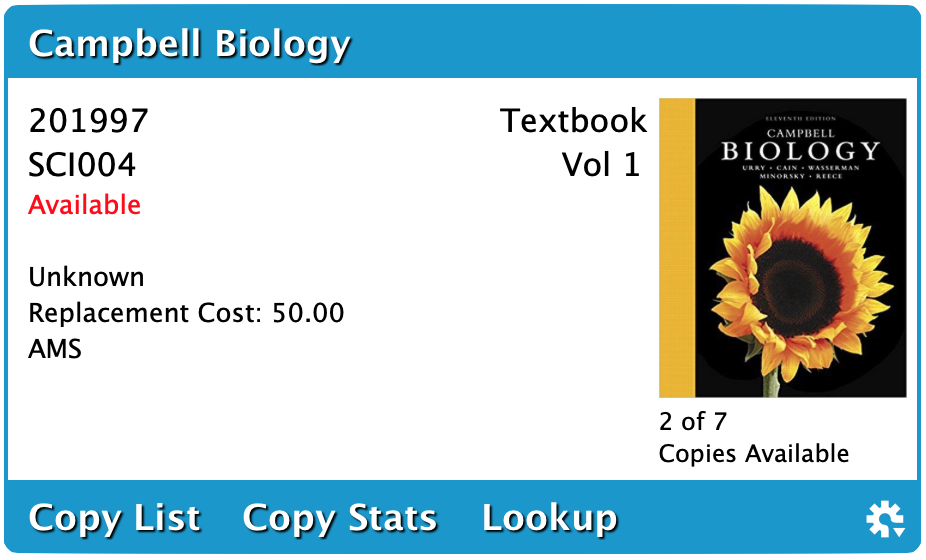Contents
The Circulation module includes a few important and distinct areas:
- Circulation toolbar on top, which includes the command line;
- Current Patron and Current Item panes in the middle;
- and the Circulation tabs at the bottom.
Hover over or click on the items on the image below for more information.

Actions
- Switch Site. Allows the operator to select which site they would like to log into. The choices offered depend on the sites the operator has permission to access (review Site Access for more information). The default selection is always the last site the operator logged into. (Centralized Catalog only)
- Log Out. Log out of Textbook Tracker.
Message Center
Operations Management
Support Documentation
Circulation Mode
Select a Circulation Mode from the dropdown menu located to the left of the Command Line. The Circulation Mode field indicates which function will be implemented when patron/item barcodes are typed or scanned. Frequently used modes are Bookdrop (B), Check Out (.), Hold (H), and Renewal (R).
| Command | Code | Usage |
|---|---|---|
Bookdrop | B | Check in an items or items for one or more patrons. |
Check Out | . | Typically used to check out library material to patrons; however, that depends on two things:
|
Discard Mode | DM | Move several copies to the Discarded Copies system patron and enter a note for each to explain why they are being discarded. |
Inventory | I | Updates the inventory date and triggers a circulation exceptions alert for all materials entered. |
Inventory Bookdrop | IB | Updates the inventory date, bookdrops the item(s), and triggers a circulation exceptions alert for all materials entered |
Inventory Bookdrop Suppressed | IBS | Used to simultaneously update the inventory date, bookdrop the items, and bypass any circulation exceptions alerts for all materials entered. |
Inventory Suppressed | IS | This updates the inventory date for each item entered and bypasses any circulation exceptions alerts. |
In Transit Mode | IT | This assigns checked out copies to the In Transit system patron (barcode 9). Afterward, the copy will be placed In Transit to its home library (whichever library is specified in the copy's Copy Site field). |
Renewal | R | Renews currently checked-out items. |
Transfer | .X | Just like Check Out (.), with one exception: When the copy that is scanned is checked out to a patron other than your current patron, instead of allowing you to bookdrop the copy, the copy will be transferred to the current patron. |
Command Line
The command line is where you enter circulation commands and/or patron and item barcodes. If you enter only a barcode, the current command mode (to the left of the command line) will determine the action to be performed. By default, the command line assumes that text input is a circulation command first and a patron/item barcode second.
Override Date. An operator-provided Override Date can appear immediately after the Command Line (see above). The function of an override date depends on the current Circulation Mode.
Command | ## | Use |
|---|---|---|
Add/Show Copy Note | ++ | Displays all notes for the current copy, or appends a note to the Copy Notes. |
Add/Show Patron Note | + | Display the Notes for the Current Patron, or appends a note to the patron General Notes. |
Bookdrop | B | Starts bookdrop mode. In bookdrop mode, all item barcodes scanned are checked in if they are checked out; and if they are already checked in, they are inventoried.To exit this mode enter a period ‘.‘ or enter a patron barcode. |
Change Barcode Number | / | Quickly change the barcode of an item or patron. Enter the old barcode and new barcode in this format: /OldBarcode=NewBarcode Textbook Tracker will update all references and then issue the new barcode to the command line. This allows you to change barcode numbers as you are checking items out, performing inventory, bookdropping items, and so on. |
Change Condition Mode | CL | Enters Change Condition Mode for the specified condition. You can also simply enter the command and a list of condition codes will be shown. To exit this mode, type a period (.) and hit enter. |
Charge a Fee | F FF | Opens the Charges subtab, or adds a charge for the current patron. Opens the History subtab. |
Charge Damage Fee | DL | Logs damage on the current copy and charges the current patron, according to the chosen Damage Code. You can also simply enter the command and a list of damage codes will be shown. Damage codes are managed in Preferences > Codes > Damage Codes. If a custom damage code is specified, you can edit the description and cost. |
Check Out | . .. | Sets Check Out mode. Sets Check Out mode without clearing override dates. |
Clear Due Date | . | Clears the Override Date and any special modes, and returns to Check Out mode. |
Clear Transaction Log | Z | Clears the Transaction Log in the Circulation display. There is no ”Undo“ for this command so use it with caution. |
Details, Patron/Item | Q | Displays Patron Details for the specified patron. If no barcode is given, the Current Patron is selected. |
Enter Barcode Range | RG | Brings up the Barcode Range window which will allow you to enter a range of barcodes to process in the current mode. For example, if you are in inventory mode when using this command, the range of barcodes you entered will be inventoried. If you are in Check Out mode with a current patron, the range of barcodes entered will be checked out to that patron. If you are in Bookdrop mode, the range of barcodes will be checked in. After the barcodes are entered a utility will be added to the operations queue to process the barcode range. |
Find Item by Title | T | Displays a list of titles. Pick the title you want from the list, and the first copy is made the Current Item. |
Find Item by Title ID [replaces by call number (C)] | C | Displays a list of titles by title ID. Pick the title you want from the list, and the first copy is made the Current Item. |
Inventory | I | Starts Inventory mode with today’s date. In Inventory mode, all item barcodes scanned are recorded as inventoried as of the date specified in the inventory command, or the current date if no date is specified. To exit this mode, type a period (.) and hit enter. |
Inventory Bookdrop Suppressed | IBS | Starts Inventory mode for the current date with automatic bookdrop and with dialogs suppressed. This mode is the same as Inventory Bookdrop mode (IB command), except that dialogs are suppressed. This mode can be used when you are performing inventory with a wireless scanner or in a similar situation. To exit this mode, type a period (.) and hit enter. |
Inventory Suppressed | IS | Starts Inventory Suppressed mode for the current date. This mode is the same as Inventory mode (I command), except that dialogs are suppressed. This mode can be used when you are performing inventory with a wireless scanner or in a similar situation. To exit this mode, type a period (.) and hit enter. |
Inventory with Bookdrop | IB | Starts Inventory mode for the current date with automatic Bookdrop. During Inventory Bookdrop, all item barcodes scanned are recorded as inventoried as of the date specified in the inventory command, or the current date if no date is specified. If the item is checked out, it is automatically checked in. To exit this mode, type a period (.) and hit enter. |
Locate Patron | L | Locate a patron by name. You can specify as much of the first or last name as you want and Alexandria will display a list of names close to the name you specified. |
Lost Copies | 1 | The Lost Copies system patron (barcode 1) allows you to maintain a record of lost items for statistical purposes without allowing them to circulate. You can remove Lost Copies with a utility. Enter 1 in the command line, then scan or type barcodes to check items out to the Lost Copies patron. |
Make Patron or Item Current | X | Clears the Current Patron and Current Item panes. |
Print Transactions | D | Prints the current receipt for the current patron. |
Renew All Items | RA | Renews all copies checked out to the current patron. If an item has a hold, and renewals are not allowed when holds are pending, or if there is a reservation on an item or it can not be renewed for some other reason, the item will not be renewed. You can override and renew an item anyway when using the Renew (R) command on an individual item. The RA command can be used to renew up to 200 items. |
Renew Item | R | Enters Renewal mode. Use Renewal mode to renew multiple checked-out items. If an item isn”t checked out, this command does nothing. To exit this mode, type a period (.) and hit enter. |
Set All Copy Locations | CH | Sets Site, Copy Location, and Copy Shelving for a number of copies. To exit this mode, type a period (.) and hit enter. |
Set All Patron Locations | PH | Sets Site, Location, and Sublocation for a number of patrons. To exit this mode, type a period (.) and hit enter. |
Set Current Patron | P [barcode] | Selects a new Current Patron. Generally, you can just enter the barcode number of a patron, but if for some reason you have patron and item barcodes that are the same, this command allows you to specify a patron directly. |
Set Due Date | .[date] | Sets an override due date. Manual due dates may be from one year in the past to any time in the future. If the date falls on a closed date, it is adjusted forward during check out. The override date will remain in use even if the patron is changed. To exit this mode, type a period (.) and hit enter. |
Transfer Mode | .X | Starts Transfer mode. When you have a current patron open, if the item you're scanning is already checked out to another person, the item will be transferred to the current patron instead of being checked in. Copies cannot be transferred to system patrons. To exit this mode, type a period (.) and hit enter. |
Current Patron
Circulation > Current Patron
Patron Details
- Patron name
- Card expiration date
- The expiration date will not be shown if Disable Card Expiration Dates is checked in Preferences > Patrons
Many Alexandria functions and commands depend on the Current Patron or Current Item. For example, you must have a Current Patron to check out, hold, or reserve an item.
The Current Patron pane consists of two areas: The larger, white area contains patron name, barcode, policy, homeroom, picture, and a short summary of the number of items checked out, on hold, reserved, with reservations, overdue, and the total fines or credits accrued; other things, such as the patron's current Lexile or Reading Level measurement, can be displayed here if you have your preferences set correctly.
The colored strip at the bottom of the pane contains buttons for Details, Notes, and Lookup; the Actions menu located at the bottom-right contains identical (and some exclusive) selections.
- Details. Contains the current patron's account status, including presently loaned items, holds, reservations, fees and other charges, and general patron information.
- Notes. Available when the current patron has associated contact, alert, categorical, or general notes. Notes are provided for patrons in the Notes tabs of Patrons Management. When clicked you are also able to add notes directly to the resulting Patron Notes dialog.
- Reserves. Provides a list of the current patron's reserves; you can remove some or all reserves from the resulting Patron Reserves dialog.
- History. Creates a Patron History report, containing the current patron's complete transaction history; if the patron's Keep Patron History box in the Statistics tab of Patrons Management is not checked, only payment and fine history are collected for this and future assessments.
Many Alexandria functions and commands depend on the Current Patron or Current Item. For example, you must have a Current Patron to check out, hold, or reserve an item.
The Current Patron pane consists of two areas: The larger, white area contains patron name, barcode, policy, homeroom, picture, and a short summary of the number of items checked out, on hold, reserved, with reservations, overdue, and the total fines or credits accrued; other things, such as the patron's current Lexile or Reading Level measurement, can be displayed here if you have your preferences set correctly.
The colored strip at the bottom of the pane contains buttons for Details, Notes, and Lookup; the Actions menu located at the bottom-right contains identical (and some exclusive) selections.
- Details. Contains the current patron's account status, including presently loaned items, holds, reservations, fees and other charges, and general patron information.
- Notes. Available when the current patron has associated contact, alert, categorical, or general notes. Notes are provided for patrons in the Notes tabs of Patrons Management. When clicked you are also able to add notes directly to the resulting Patron Notes dialog.
- Reserves. Provides a list of the current patron's reserves; you can remove some or all reserves from the resulting Patron Reserves dialog.
- History. Creates a Patron History report, containing the current patron's complete transaction history; if the patron's Keep Patron History box in the Statistics tab of Patrons Management is not checked, only payment and fine history are collected for this and future assessments.
- Lookup. Opens the Patron Lookup dialog, allowing you to search your database for patron records; performs the same action as using the “L” command.
Current Item
Many Alexandria functions and commands depend on the Current Patron or Current Item. For example, you must have a Current Patron to check out, hold, or reserve an item.
The Current Item pane consists of two areas: The white area contains the copy, barcode, policy, call number, status, picture, and a short summary of available title copies. The colored strip at the bottom of the pane is where the buttons for item Details, Copy Stats, Notes, and Lookup; the Actions menu located at the bottom-right contains identical (and some exclusive) selections.
- Details. Contains the status for all the copies of the associated title record; particulars include copies that are currently checked out, the patron(s) currently borrowing them, their due date(s), the bibliographic record, and any additional attachments.
- Notes. Available when the current copy has associated copy or alert notes. Notes are provided for copies in the Copies: Notes subtab of Items Management. When clicked, you are also able to add notes directly to the resulting Copy Notes dialog.
- Reserves. Provides you with a list of patrons with reserves on the current copy.
- Show Map. If the current copy's Call Number falls within the Call Number range of a corresponding map (created in Maps Management), selecting Show Map will display the the map, detailing where the copy is located in your library. These maps can be conveniently printed from your browser and handed to interested patrons. If the current copy lacks a Call Number (or there is no map with an associated call number range), the Show Map selection is disabled.
- Lookup. Opens an Item Lookup dialog, allowing you to search your catalog; performs the same function as using the “ST” command.
- Vendors. This selection opens a secondary menu containing a list of Alexandria third-party partners that, when selected, link to their respective websites. Individual vendors can be disabled from Extras Preferences.
Commands



